The EPA and state agencies continue to work toward finding balance related to enforcement actions. Most recently, the EPA updated its with a .
On a similar note, EPA Administrator Andrew Wheeler requested a consideration in rulemaking processes to improve consistency and transparency.
In addition to these topics, we selected the following articles from BC’s BLR source to provide additional regulatory updates:
EPA opens public comment on draft recommendations for PFAS levels found in groundwater
Following the EPA’s initial for per- and polyfluoroalkyl substances (PFAS) released in February, the agency started a public comment period regarding its . Only five pages in length, the preliminary guidance highlights groundwater contaminated with perfluorooctanoic acid (PFOA) and perfluorooctane sulfonate (PFOS) at sites already under federal CERCLA, or Superfund, and RCRA programs.
In addition to this guidance, seven states are developing standards that have lower limits than this guidance document for PFOA, PFOS, and other PFAS.
Get to know used oil PCB regulations to avoid costly mistakes
Although polychlorinated biphenyls (PCBs) were banned in most manufacturing and processing 40 years ago, the contaminant still causes problems for oil collection centers and recyclers today. PCBs are still found in motor oil or are accidentally mixed with used oil, which can trigger Toxic Substances Control Act (TSCA) regulations.
Making this mistake could result in large fines from TSCA enforcement, which in one circumstance equated to as much as $206,000. To stay informed on the subject, keep Preventing and Detecting PCB Contamination in Used Oil on hand.
EPA takes a stance on the Clean Water Act’s groundwater dispute
Earlier this spring, the Clean Water Act (CWA) was clearly headed to the nation’s highest court after three U.S. Appeal Courts made opposing opinions regarding the CWA’s National Pollutant Discharge Elimination System (NPDES) regulating power over groundwater pollution leaks. Now, the EPA is asserting its position on the issue as well, stating that NPDES has never covered groundwater discharge, but instead leaves this up to a state’s jurisdiction.
Those groundwater discharge activities affected include aquifer recharge, leaks from sewage collection systems, septic system discharges, and treatment systems. The CWA’s jurisdiction is also linked to scrutiny regarding the definition of Waters of the United States (WOTUS).


